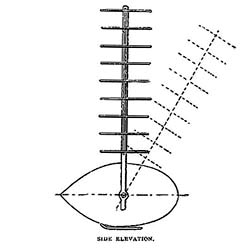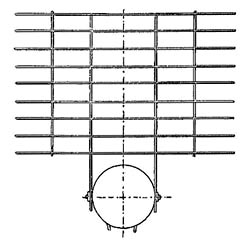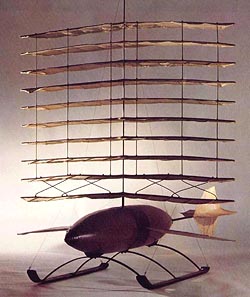
Charles Renard (1847 - 1905)
Progress in Flying Machines At the Paris Exposition of 1889, Commandant Renard, of the French Aeronautical Department, exhibited, in connection with the dirigible war balloon "La France," an apparatus which he had designed some years before (1873) as embodying his conception of a flying machine, and which he termed a "dirigible parachute." This is shown in fig. 64, and consists in an oviform body, to which is pivoted a couple of standards carrying a series of narrow and long superposed flat blades, intended to sustain the machine when gliding downward through the air.
 fig. 64, Renard's "Dirigible Parachute", 1889 http://invention.psychology.msstate.edu
The dotted lines in the side view indicate the maximum angle of inclination which it was proposed to give to this similitude of a Venetian blind, and it is evident that by setting it at the proper angle, and dropping the apparatus from a balloon, it can be made to travel back against the wind a considerable distance, and also that it ma' be steered laterally by the addition of a rudder. Beneath the body a sort of skate will be noticed, probably intended to glide over the ground in alighting, or in obtaining initial velocity to rise should a motor be applied; but the French War Department is reticent concerning its experiments in aerial navigation, and the writer has been unable to gather any information concerning the working of this apparatus.
 fig. 64, Renard's "Dirigible Parachute", 1889 http://invention.psychology.msstate.edu
It will be noted that Commandant Renard proposed to equip this machine with flat blades, thus conforming to the predilection in favor of plane surfaces exhibited by most of the experimenters with aeroplanes already noticed except Captain Le Bris and M. Goupil who took a different view as to the best shapes to employ. In point of fact, as already intimated, those who have succeeded in the air, the true experts in gliding, the soaring birds, do not perform their evolutions with plane surfaces. Their wings are more or less convex on top and concave beneath, and are warped surfaces of complicated outlines. It is true that in many cases they do not differ greatly from planes, and the mind of man so strongly tends to the simplification of complicated shapes, that most inventors have assumed that the effect on the air will be practically the same. Flight is possible with flat planes, as witness the butterfly, the dragon fly, and insects generally, but such creatures are endowed with greater relative power, as already explained; and, moreover, the elasticity of their wings produces change of shape under action. In the case of the birds, although the outer ends of the feathers are elastic, yet the wing is stiffer as a whole, and the curved surfaces may prove more efficient than planes in obtaining support from the air.
Flying Machines: Construction and Operation
Chapter I. Evolution of Two Surface Flying Machine : Renard's "Dirigible Parachute" I am asked to set forth the development of the "two-surface" type of flying machine which is now used with modifications by Wright Brothers, Farman, Delagrange, Herring and others. This type originated with Mr. F. H. Wenham, who patented it in England in 1866 (No. 1571), taking out provisional papers only. In the abridgment of British patent Aeronautical Specifications (1893) it is described as follows:
Two or more aeroplanes are arranged one above the other, and support a framework or car containing the motive power. The aeroplanes are made of silk or canvas stretched on a frame by wooden rods or steel ribs. When manual power is employed the body is placed horizontally, and oars or propellers are actuated by the arms or legs. A start may be obtained by lowering the legs and running down hill or the machine may be started from a moving carriage. One or more screw propellers may be applied for propelling when steam power is employed.On June 27, 1866, Mr. Wenham read before the "Aeronautical Society of Great Britain," then recently organized, the ablest paper ever presented to that society, and thereby breathed into it a spirit which has continued to this day. In this paper he described his observations of birds, discussed the laws governing flight as to the surfaces and power required both with wings and screws, and he then gave an account of his own experiments with models and with aeroplanes of sufficient size to carry the weight of a man. ...and as it applies to Charles Renard (1847 - 1905)... [Ed] In 1889 Commandant Renard, the eminent superintendent of the French Aeronautical Department, exhibited at the Paris Exposition of that year, an apparatus experimented with some years before, which he termed a dirigible parachute.
 Renard's "Dirigible Parachute", 1889 image courtesy Philippe Gervias
It consisted of an oviform body to which were pivoted two upright slats carrying above the body nine long superposed flat blades spaced about one-third of their width apart. When this apparatus was properly set at an angle to the longitudinal axis of the body and dropped from a balloon, it travelled back against the wind for a considerable distance before alighting. The course could be varied by a rudder.
 Renard's "Dirigible Parachute", 1889 image courtesy Philippe Gervias Download 750pixel image No practical application seems to have been made of this device by the French War Department, but Mr. J. P. Holland, the inventor of the submarine boat which bears his name, proposed in 1893 an arrangement of pivoted framework attached to the body of a flying machine which combines the principle of Commandant Renard with the curved blades experimented with by Mr. Phillips, now to be noticed, with the addition of lifting screws inserted among the blades.
www.flight100.org In 1784, just one year after the first flights of man-operated balloons, the French inventor G. Meusnier proposed a design for a streamlined propelled and steerable balloon. The design was a forerunner of dirigibles. The first flight of a dirigible was accomplished by another French pioneer, Henri Giffard, in September 1852 in an airship powered by a 3 HP steam-engine. In 1884, two French officers, Charles Renard and Arthur Krebs, made a five-mile trip aboard the dirigible, La France, powered by an electric motor. ... Then, in France, the transition from lighter-than-air balloons to aircraft took place. Col. Charles Renard and his assistant, Capt. Ferdinand Ferber, set up the first facility in the world for testing aircraft models as well as engines and propellers (1904) at Chalais-Meudon.
|
© Copyright 1999-2002 CTIE - All Rights Reserved - Caution |